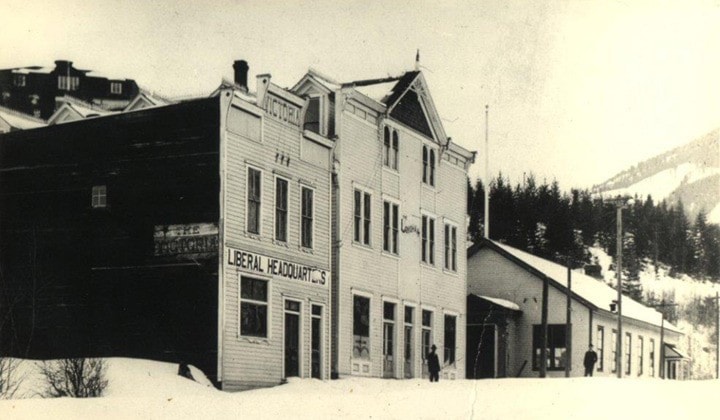Fifth in a series
What else was the Langham building in Kaslo home to in its early years besides a bottling works and rooming house?
We’ve seen previously that the Bank of British North America briefly located there and Charles J. Kapps ran his Slocan Bottling Works out of a since-demolished addition. Alfred J. Curle, the benevolent man children called Unc Curle, bought the building with surveyor A.R. Heyland from Kapps in 1910. They were still co-owners as of 1915, but by 1925 Curle was sole owner.
According to Kaslo: The First 100 Years, published in 1993, “the first floor was used mainly for businesses like mining company and livery offices … As the boom times eased themselves across the threshold of the 20th century and into the inevitable recession … a long succession of short-term and long-term tenants took up residence … There was a wide variety of tenancies — the Hewbard & Waltz Lumbering office, the Goodenough Stables (a freight and livery company), and a myriad of promoters and general offices. Upstairs, the rooms and apartments were available to let by the week or month.”
The book’s sources are unknown, although we know Arthur Goodenough bought the bottle works from Kapps. Maybe he had a livery company too.
The lumber outfit was actually Howland & Waltz, a Minnesota pulp company that held large timber limits on Kootenay Lake. We know this because of a story in the Vancouver Daily World of March 28, 1923 and a classified ad in the Spokane Daily Chronicle of May 11, 1936, offering the company’s equipment for sale, “as it stands stored in the Langham block or in sheds at Kaslo.”
Surveyor and mining engineer Howard D. Dawson had an office in the Langham in the 1920s. He might have taken over A.R. Heyland’s practice but Dawson’s daughter, Isabel Ramsay, 96, of Nelson, isn’t sure.
She vaguely remembers being in the Langham as a little girl. “It was a vast building with many rooms, mainly occupied by renters,” she says. “In the ’20, it was a busy place. Then it became downtrodden.”
Kaslo: The First 100 Years says: "By the 1930s, the large uninsulated building was underutilized — at times totally abandoned. Early in that decade Jack Riddell, a master carpenter, moved his shop and lumber storeroom into the Langham, and remained until the early 1940s.”
As of 1940, building owner Curle was behind in his taxes $107 on one lot and $156 on the other ($1,672 and $2,425 in today’s currency).
Around that time, tailor Levi Hilts came to Kaslo from Trail with teenage sons Ralph and Leslie. They lived on the Langham’s second floor and looked after the building. Levi is listed in the Kaslo civic directory from 1940-42. Afterward, they returned to Trail.
By the summer of 1942, all arrears on the Langham were paid up — likely by the BC Security Commission, which leased the building to house Japanese Canadians forcibly displaced from the Lower Mainland. The Langham became home to about 80 people — six or eight to a room. (We’ll learn more about this period in the next installment.)
Peggy and John Strachan and their three children lived in the building in the late 1940s in a second-floor apartment on the rear west side.
“I still remember climbing the stairs at the back,” says their niece, Barbara Bavington. “Uncle John and my uncle Jim Rouleau had an electronics and carpentry business out of the first floor. They never made any money at it because uncle John was so meticulous that it took forever to get anything made.”
By the early 1950s, Tomio Baba acquired the building and used the ground floor to build fishing boats that were shipped by barge and rail to the coast. Noreen Halleran also gave children’s music lessons in what’s now the northwest gallery on the ground floor.
Kaslo: The First 100 Years continues: “This breath of life for the Langham lasted until the early ‘70s when Mr. Baba sold the Langham to Walter Schmidt, a Cape Cod resident who saw the building’s potential but could not afford even basic maintenance.”
Next: The Langham in wartime
Previously
Part 4: Rowdy days for the Langham boys
